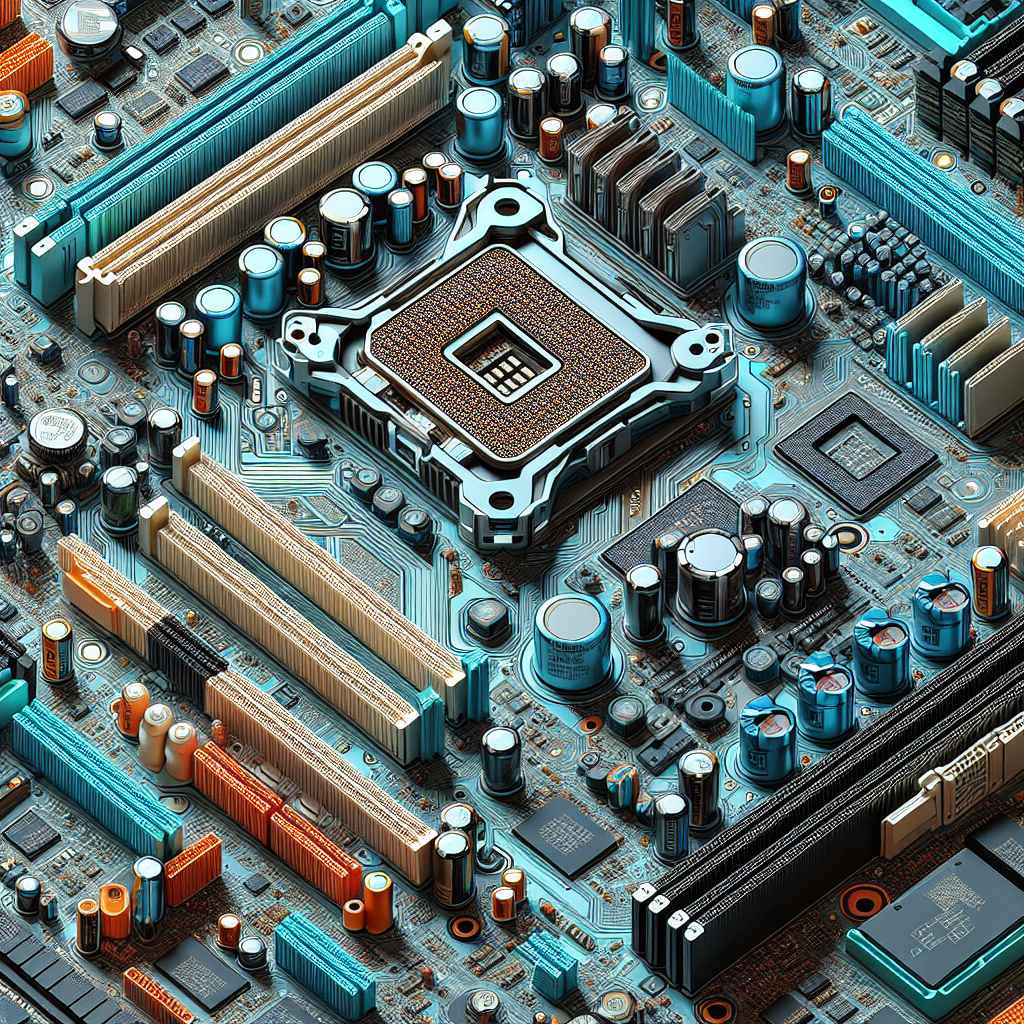So you’ve always been fascinated by artificial intelligence and want to try your hand at creating your own AI on your computer? Well, you’re in luck! In this article, we’ll show you step-by-step how to embark on this exciting journey. From choosing the right software to understanding the fundamentals of AI programming, we’ve got you covered. By the end of this article, you’ll be well on your way to developing your very own AI and diving into the world of cutting-edge technology. Let’s get started!
Understanding the Basics of AI
Defining AI: A Brief Overview
Artificial Intelligence (AI) refers to the simulation of human-like intelligence in machines that are programmed to mimic cognitive functions such as learning, problem-solving, and decision-making. AI systems are designed to analyze vast amounts of data, recognize patterns, and make predictions or take actions based on the information processed. AI can be categorized into two types: weak AI and strong AI.
Different types of AI: From Weak to Strong AI
Weak AI, also known as Narrow AI, is designed to perform specific tasks within a limited scope. It is built to excel in a particular domain, such as voice assistants, recommendation systems, or image recognition. On the other hand, strong AI, also known as Artificial General Intelligence (AGI), aims to possess human-level intelligence and exhibit the ability to understand, learn, and apply knowledge across various domains.
Common Applications of AI in Everyday Life
AI has become an integral part of our daily lives, impacting various industries and sectors. Some common applications of AI include virtual personal assistants like Siri and Alexa, recommendation systems used by online platforms, fraud detection systems in banking, autonomous vehicles, and even medical diagnostics. AI enhances efficiency, productivity, and decision-making in these areas, making our lives more convenient and streamlined.
Key Terminologies Used in AI
To effectively understand and work with AI, it is essential to familiarize yourself with the key terminologies used in this field. Some important terms include Machine Learning (ML), which refers to the ability of a system to automatically learn and improve from data without being explicitly programmed. Neural Networks are computational models inspired by the human brain’s structure and function, used in deep learning algorithms. Natural Language Processing (NLP) involves training machines to understand and interpret human language. Additionally, Robotics and AI focus on creating intelligent machines capable of performing tasks autonomously.
Essential Pre-requisites for Creating an AI
Understanding Required Hardware Specifications
When it comes to creating your AI, having the right hardware specifications is crucial. AI development requires a powerful computer with high processing capabilities. A computer with a multicore CPU, a significant amount of RAM, and a dedicated GPU can greatly accelerate AI training and improve performance. Additionally, having sufficient storage space is necessary for storing large datasets and models.
Importance of a Good Internet Connection
A reliable internet connection plays a vital role in AI development. Training AI models often involves accessing and processing massive amounts of data from online sources. Without a stable internet connection, you may encounter difficulties in gathering data, downloading necessary libraries and frameworks, or collaborating with remote teams. Therefore, choosing a high-speed internet provider is essential to ensure smooth AI development.
Basic Programming Skills Required
To create an AI, fundamental programming skills are required. Familiarity with programming languages like Python, Java, Lisp, Prolog, or C++ is advantageous. These languages are commonly used in AI development due to their simplicity, flexibility, and extensive libraries and frameworks. Python, in particular, has gained popularity in the AI community due to its readability and vast ecosystem of AI-specific libraries.
Understanding the Role of Machine Learning and Neural Networks in AI
Machine Learning (ML) is a subset of AI that focuses on training models to learn patterns and make predictions from data. ML algorithms enable computers to learn from examples, iterative adjustments, and feedback to improve their performance over time. Neural Networks, inspired by the human brain, play a vital role in ML. These interconnected layers of artificial neurons process data and provide output, allowing machines to recognize complex patterns and make intelligent decisions.
Choosing Your AI Development Language
Choosing Between Python, Java, Lisp, Prolog, and C++ for AI Development
While several programming languages can be used for AI development, Python, Java, Lisp, Prolog, and C++ are among the most popular choices. Python, with its simplicity and versatility, has emerged as a preferred language due to its extensive libraries such as TensorFlow, PyTorch, and Scikit-learn, which facilitate AI development. Java offers robustness and scalability, making it suitable for AI applications that require heavy computation. Lisp and Prolog, although less mainstream, have a strong foundation in AI research and provide unique features for specific AI domains. C++ is known for its efficiency and can be advantageous for AI applications that require real-time processing.
Importance of Python in AI Development
Python has gained significant popularity in the AI community due to its simplicity, readability, and extensive ecosystem. It offers a wide range of AI-specific libraries such as TensorFlow, PyTorch, Keras, and Scikit-learn, which simplify the implementation of complex AI algorithms. Python’s simplicity allows developers to focus more on the logic of their AI rather than getting bogged down by complex syntax. Furthermore, Python’s vast community support and numerous learning resources make it an ideal choice for beginners and seasoned developers alike.
Learning Resources for Python
For individuals interested in learning Python for AI development, there is a plethora of learning resources available. Online platforms like Coursera, edX, and Udemy offer comprehensive AI and Python courses. Books like “Python Machine Learning” by Sebastian Raschka and “Deep Learning with Python” by François Chollet provide in-depth insights into AI algorithms and their implementation in Python. Additionally, online AI communities and forums like Stack Overflow and GitHub offer valuable resources, tutorials, and code repositories for AI development in Python.
Getting Familiar with AI Libraries in Python
To effectively develop AI applications in Python, gaining familiarity with AI-specific libraries is essential. TensorFlow, developed by Google, is one of the most popular libraries for building and training neural networks. PyTorch, developed by Facebook’s AI Research Lab, is widely used for deep learning due to its dynamic computational graph and intuitive interface. Keras, built on top of TensorFlow and compatible with other AI libraries, provides a user-friendly API for building and training neural networks. Scikit-learn offers a wide range of ML algorithms, making it suitable for various AI applications. Exploring these libraries and their documentation can help unlock the full potential of Python in AI development.
Setting Up Your Development Environment
Choosing and Installing an IDE
Setting up a suitable Integrated Development Environment (IDE) is crucial for efficient AI development. IDEs provide developers with a comprehensive set of tools, such as code editors, debuggers, and project management features. Popular IDEs for AI development include PyCharm, Visual Studio Code, and Jupyter Notebook. PyCharm, with its robust features and compatibility with various AI libraries, offers a seamless development experience. Visual Studio Code, a lightweight and extensible IDE, provides excellent support for Python and integrates well with AI-specific libraries. Jupyter Notebook, favored for its interactive and notebook-style interface, allows developers to combine live code, visualizations, and documentation in a single document.
Setting Up Python Environment for AI
Once you have chosen an IDE, setting up the Python environment becomes crucial. It is recommended to use a virtual environment, such as Anaconda or virtualenv, to create an isolated Python environment for AI development. Virtual environments allow you to manage and install specific versions of Python and associated libraries without affecting the system-wide Python configuration. Anaconda, a popular Python distribution, provides a user-friendly platform for managing packages, environments, and dependencies, making it an excellent choice for AI development.
Introduction to Jupyter Notebook
Jupyter Notebook, an interactive computing environment, has gained immense popularity in AI and data science communities. Its notebook-style interface allows developers to write and execute code, view visualizations, and add explanatory text in a single document. Jupyter Notebook supports various programming languages, including Python, and enables the creation of reproducible and shareable AI projects. Its versatility and ability to combine documentation with code make it an invaluable tool for AI development and collaboration.
Understanding the Basics of Anaconda
Anaconda, a widely-used Python distribution, simplifies the installation and management of Python packages and environments. It comes pre-packaged with popular AI libraries and tools, providing a seamless AI development experience. Anaconda Navigator, a graphical user interface (GUI) that comes bundled with Anaconda, allows you to access and manage packages, environments, and development tools effortlessly. Understanding the basics of Anaconda, including package management and environment creation, is essential for smooth AI development on your computer.
Learning Key AI Concepts
Intro to Machine Learning and Deep Learning
Machine Learning (ML) is a subfield of AI that focuses on enabling computers to learn patterns and make predictions from data without being explicitly programmed. ML algorithms can be broadly categorized into supervised learning, unsupervised learning, and reinforcement learning. Supervised learning involves training AI models using labeled data, while unsupervised learning aims to discover patterns in unlabeled data. Reinforcement learning focuses on training AI models through a system of rewards and punishments.
Deep Learning, a subset of ML, deals with neural networks that mimic the structure and function of the human brain. Deep Learning algorithms enable machines to learn and make predictions by processing vast amounts of data through layers of artificial neurons. These neural networks have been successful in various AI domains, including image recognition, natural language processing, and speech synthesis.
Understanding Neural Networks
Neural Networks are a fundamental component of AI and function as the building blocks of deep learning algorithms. Inspired by the human brain, neural networks are composed of interconnected layers of artificial neurons. Each neuron processes input data, applies an activation function, and produces an output that serves as input for subsequent layers. By adjusting the weights and biases of these neurons during training, neural networks can learn and generalize patterns from data, allowing machines to make intelligent decisions.
Basics of Natural Language Processing
Natural Language Processing (NLP) focuses on enabling machines to understand and interpret human language. It involves various techniques such as text classification, sentiment analysis, speech recognition, and machine translation. NLP leverages AI algorithms to extract meaning and context from text or speech, making it possible to develop applications like chatbots, language translators, and voice assistants. Understanding the basics of NLP is crucial for creating AI applications that interact effectively with humans.
Fundamentals of Robotics and AI
Robotics and AI combine to create intelligent machines capable of autonomous action. Robotics involves integrating AI technologies into physical systems to enable machines to sense, process information, and make decisions or perform tasks in real-world environments. The fundamentals of robotics and AI encompass areas such as computer vision, sensory perception, motion planning, and control systems. Developing a comprehensive understanding of the interaction between robots and AI is vital for creating AI-powered autonomous systems.
Introduction to AI Platforms
Overview of TensorFlow
TensorFlow, developed by Google, is an open-source AI platform widely used for building and training machine learning models. It provides an extensive ecosystem of tools, libraries, and resources that cater to various AI domains. TensorFlow’s flexibility and scalability make it suitable for both research and production-level AI projects. With its rich set of APIs and support for multiple programming languages, including Python and C++, TensorFlow enables developers to create and deploy AI models efficiently.
Understanding the Functionality of PyTorch
PyTorch, developed by Facebook’s AI Research Lab, is a popular open-source machine learning framework. It offers a dynamic computational graph, which allows developers to modify models on-the-fly during runtime. PyTorch provides an intuitive interface for building and training neural networks and supports advanced features such as automatic differentiation. Its flexibility and ease of use have made it a preferred choice for researchers and developers working on deep learning projects.
Basics of IBM’s Watson
IBM’s Watson is a powerful AI platform that leverages natural language processing and machine learning algorithms to analyze large volumes of data, extract insights, and provide intelligent solutions. Watson’s capabilities extend to various domains, including healthcare, finance, and customer service. With its easy-to-use APIs and pre-trained models, Watson allows developers to integrate AI-driven functionalities into their applications quickly. Understanding the basics of IBM’s Watson can open up opportunities for creating AI-powered solutions in various industries.
Intro to Microsoft’s Azure AI
Microsoft’s Azure AI platform offers a comprehensive suite of services and tools for developing and deploying AI solutions. Azure AI includes services such as Azure Machine Learning, a cloud-based platform for building, training, and deploying machine learning models, and Azure Cognitive Services, which provides pre-built AI models for vision, speech, language, and search functionalities. Azure AI’s integration with other Azure services, scalability, and security features make it a robust platform for AI development and deployment.
Planning Your First AI Project
Identifying a Problem to Solve
Before diving into AI development, it is crucial to identify a problem or challenge that can be solved using AI. Start by assessing the domains where AI can make a significant impact and narrow down to a specific problem within that domain. Consider factors such as data availability, complexity, and feasibility while selecting your project. Having a well-defined problem statement is the first step towards creating a successful AI project.
Collecting and Preparing Your Data
Data is the lifeblood of AI projects, and collecting and preparing relevant data is essential for training AI models effectively. Identify the data sources that are required for your project and gather datasets that are representative and diverse enough to capture the problem’s variations. Preprocessing data, which includes cleaning, normalizing, and encoding, is necessary to ensure data quality and compatibility with AI algorithms.
Designing Your AI Model
Designing an AI model involves determining the architecture, algorithms, and parameters that best suit your problem. Consider the type of problem (classification, regression, etc.), the nature of your data, and the resources available when deciding on the model structure. Choose appropriate ML algorithms and adjust hyperparameters to optimize the model’s performance. Iterative experimentation and validation are key in refining and improving your AI model.
Testing and Refining Your Model
Testing and refining your AI model is an iterative process that requires evaluating its performance and progressively improving it. Split your dataset into training, validation, and testing sets to assess the model’s accuracy, precision, recall, and other metrics. Analyze the model’s performance, identify areas for improvement, and fine-tune the model by adjusting algorithms, parameters, or data preprocessing techniques. Continuously test and refine your model until it achieves the desired accuracy and efficiency.
Coding Your AI
Writing Your First AI Script
Once your AI model is designed and tested, it’s time to start coding. Begin by writing the necessary scripts to implement your AI model. Depending on the programming language and libraries being used, this may involve defining the model’s architecture, preprocessing data, training the model, and making predictions. Understand the syntax and conventions of the chosen programming language to ensure readable and efficient code.
Implementing Machine Learning Algorithms
Implementing machine learning algorithms is a critical aspect of coding your AI. Depending on the type of problem and the chosen ML algorithm, you will have to integrate appropriate algorithms into your code. This may include implementing algorithms for data preprocessing, feature extraction, dimensionality reduction, and model training. Leverage the AI libraries and frameworks available in your chosen programming language to simplify the implementation of complex ML algorithms.
Adding a Natural Language Processing Component
If your AI project involves natural language processing (NLP), incorporate NLP components into your code. This may include tokenizing text, converting text into numerical vectors, applying feature extraction techniques, or training language models. NLP libraries and frameworks provide useful functionalities for processing text and documents, making it easier to develop AI applications involving human language.
Incorporating Image Recognition
If your AI project involves image recognition, computer vision, or object detection, incorporate relevant components into your code. Image recognition algorithms can be implemented using image processing techniques, deep learning models, or pre-trained models available in AI libraries. Process images, extract features, and train your model using labeled image datasets. Incorporating image recognition capabilities adds visual understanding to your AI system.
Testing and Refining Your AI
Why it’s Important to Test Your AI
Testing your AI is crucial to ensure its reliability, accuracy, and robustness. Test your AI system by feeding it with different inputs, both during the development process and after the deployment. Evaluate its performance against expected outputs and measure key metrics such as accuracy, precision, recall, and F1-score. Conducting thorough testing helps identify and fix bugs, validate the AI’s performance, and improve its overall quality.
Tips for Debugging Your AI Code
Debugging AI code can be challenging, given the complexity and intricacies of the algorithms involved. To effectively debug your code, start by isolating the problem area and narrowing down potential causes. Utilize debugging tools provided by your programming language or IDE to step through the code and identify errors or unexpected behavior. Monitor intermediate outputs, validate input data, and verify the correctness of model predictions to pinpoint and resolve issues.
Refining Your AI for Better Performance
Refining your AI model is an ongoing process that involves identifying areas for improvement and making necessary adjustments. Analyze the performance metrics of your AI system and identify specific factors that contribute to its limitations. Experiment with alternative algorithms, adjust hyperparameters, or explore more extensive and diverse datasets to enhance the model’s accuracy and efficiency. Continuous refinement and optimization are essential for improving your AI’s performance over time.
Evaluating the Success of Your AI
Evaluating the success of your AI goes beyond performance metrics. Assess the impact of your AI system on the problem it was designed to solve. Measure how well it addresses the original problem statement, its effectiveness in real-world scenarios, and the satisfaction and feedback of users or stakeholders. A successful AI project not only achieves high accuracy and performance but also delivers tangible value and meets the desired objectives.
Application of Your AI
Using Your AI in Real-Life Situations
Once your AI model is developed and refined, it can be applied to real-life situations. Integrate your AI system into the desired environment or platform, whether it’s a web application, a mobile app, or an embedded system. Ensure that the necessary infrastructure and resources are in place to support the deployment and scalability of your AI. Continuously monitor and evaluate your AI’s performance in real-life scenarios and make necessary updates or improvements based on feedback and evolving requirements.
Possible Issues and Ethical Considerations
As AI becomes more pervasive in our lives, it is essential to be aware of the possible issues and ethical considerations associated with its usage. AI systems may exhibit bias in decision-making if trained on biased or unrepresentative datasets, leading to unfair outcomes. Privacy and security concerns arise when dealing with sensitive user data. Transparency, accountability, and explainability are crucial aspects when deploying AI in critical domains such as healthcare or finance. It is important to consider and address these issues to ensure responsible AI development and deployment.
Continuously Improving Your AI for Better Results
AI development doesn’t end with the deployment of your system. Continuously monitor its performance, collect feedback, and gather new data to improve the accuracy, efficiency, and versatility of your AI. Incorporate user feedback and keep up with advancements in AI research and techniques. Explore new algorithms, models, or features that can enhance your AI’s capabilities. By taking an iterative approach to improvement, you can ensure that your AI stays relevant and effective in a rapidly evolving technological landscape.
Looking Towards the Future: AI in the Next 10 Years
The future of AI holds immense possibilities and advancements across various domains. In the next 10 years, AI is expected to further integrate into our daily lives, revolutionizing industries such as healthcare, transportation, finance, and education. AI-powered autonomous systems, robotics, and smart devices will become increasingly prevalent. Advances in natural language processing, computer vision, and reinforcement learning will enable more sophisticated AI applications. However, concerns regarding AI ethics, privacy, and societal impact will require careful attention and regulation. Embracing the potential of AI while ensuring responsible development and deployment will shape the path of innovation in the coming years.



